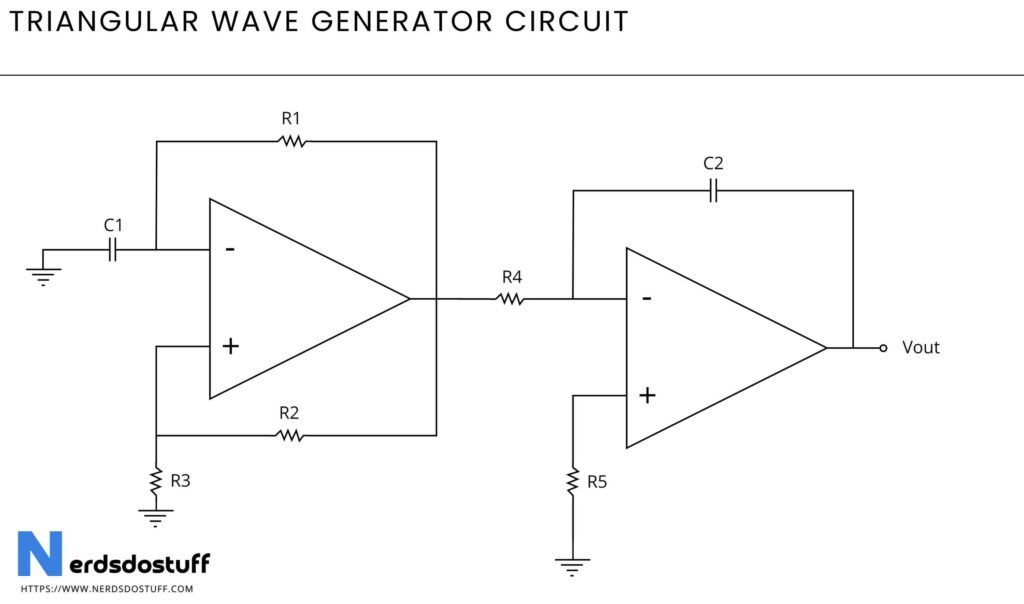What is Triangular Wave Generator
A triangular wave generator is an electronic circuit or device that produces a waveform characterized by linearly increasing and decreasing voltage levels, forming a triangular shape over time. It typically consists of an oscillator circuit that generates a continuous oscillation, and a voltage-controlled ramp generator that produces a voltage waveform with linearly increasing and decreasing slopes. The triangular waveform alternates between its peak positive and negative voltage levels at a fixed frequency, resulting in a waveform with symmetrically sloping edges. Triangular wave generators are used in electronic systems for applications such as waveform synthesis, modulation, frequency generation, and testing and calibration of electronic equipment.
Triangular Wave Generator Circuit

Working of Triangular Wave Generator
A triangular wave generator operates by using an oscillator circuit to produce a continuous oscillation, while a voltage-controlled ramp generator generates a voltage waveform with linearly increasing and decreasing slopes. The ramp generator’s output voltage increases linearly until it reaches a peak value, then decreases linearly until it reaches its minimum value, and the cycle repeats. This triangular waveform is produced at a fixed frequency determined by the oscillator circuit. The ramp generator’s output voltage alternates between its peak positive and negative levels, forming a triangular waveform with symmetrically sloping edges.
Characteristics of Triangular Wave Generator
| Characteristic | Description |
|---|---|
| Output Waveform | Generates a triangular waveform as its output signal, characterized by linearly increasing and decreasing voltage levels forming a triangular shape over time. |
| Oscillator Circuit | Utilizes an oscillator circuit to produce a continuous oscillation, determining the frequency of the triangular waveform. |
| Voltage-Controlled Ramp Generator | Incorporates a voltage-controlled ramp generator to generate the linearly increasing and decreasing slopes of the triangular waveform. |
| Symmetric Sloping Edges | The triangular waveform has symmetrically sloping edges, with equal rise and fall times. |
| Fixed Frequency | The frequency of the triangular waveform is fixed and determined by the oscillator circuit. |
| Applications | Widely used in electronic systems for applications such as waveform synthesis, modulation, frequency generation, and testing and calibration of electronic equipment. |
Applications of Triangular Wave Generator
- Waveform Synthesis: Triangular wave generators are used in waveform synthesis applications to generate precise triangular waveforms for testing and simulating electronic circuits and systems.
- Modulation: Triangular wave generators are employed in modulation techniques such as frequency modulation (FM) and phase modulation (PM) to generate modulation signals. These modulation signals are then combined with carrier signals to transmit information in communication systems.
- Frequency Generation: Triangular wave generators can be used to generate frequency-modulated signals for applications such as frequency synthesizers, signal generators, and frequency-shift keying (FSK) modulation.
- Signal Calibration: Triangular wave generators are utilized in calibration procedures to verify and calibrate the accuracy of testing and measurement equipment such as oscilloscopes, spectrum analyzers, and signal generators.
- Function Generators: Triangular wave generators are integrated into function generator circuits to produce a wide range of periodic waveforms, including sine waves, square waves, and triangular waves. Function generators are essential tools in laboratory settings for various testing and measurement applications.
- Audio Applications: In audio synthesis and music production, triangular wave generators can be used to create unique sound effects and synthesizer patches. Although triangular waves are less commonly used in music compared to sine and square waves, they can add depth and character to audio compositions.
- Phase-Locked Loops (PLLs): Triangular wave generators are used in phase-locked loop (PLL) circuits to generate reference signals for phase detection and frequency synthesis. PLLs are widely used in telecommunications, data communication, and frequency synthesis applications.
- Ramp Generators: Triangular wave generators are often used as ramp generators in analog circuits for various purposes, including voltage sweep applications, pulse generation, and voltage-controlled oscillators (VCOs).




